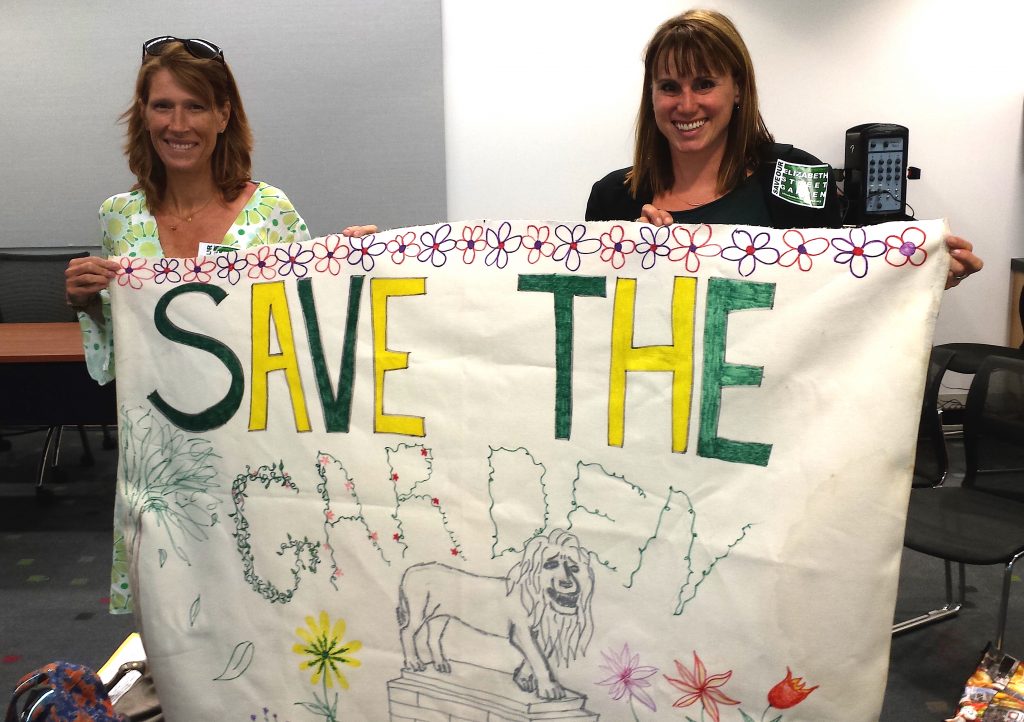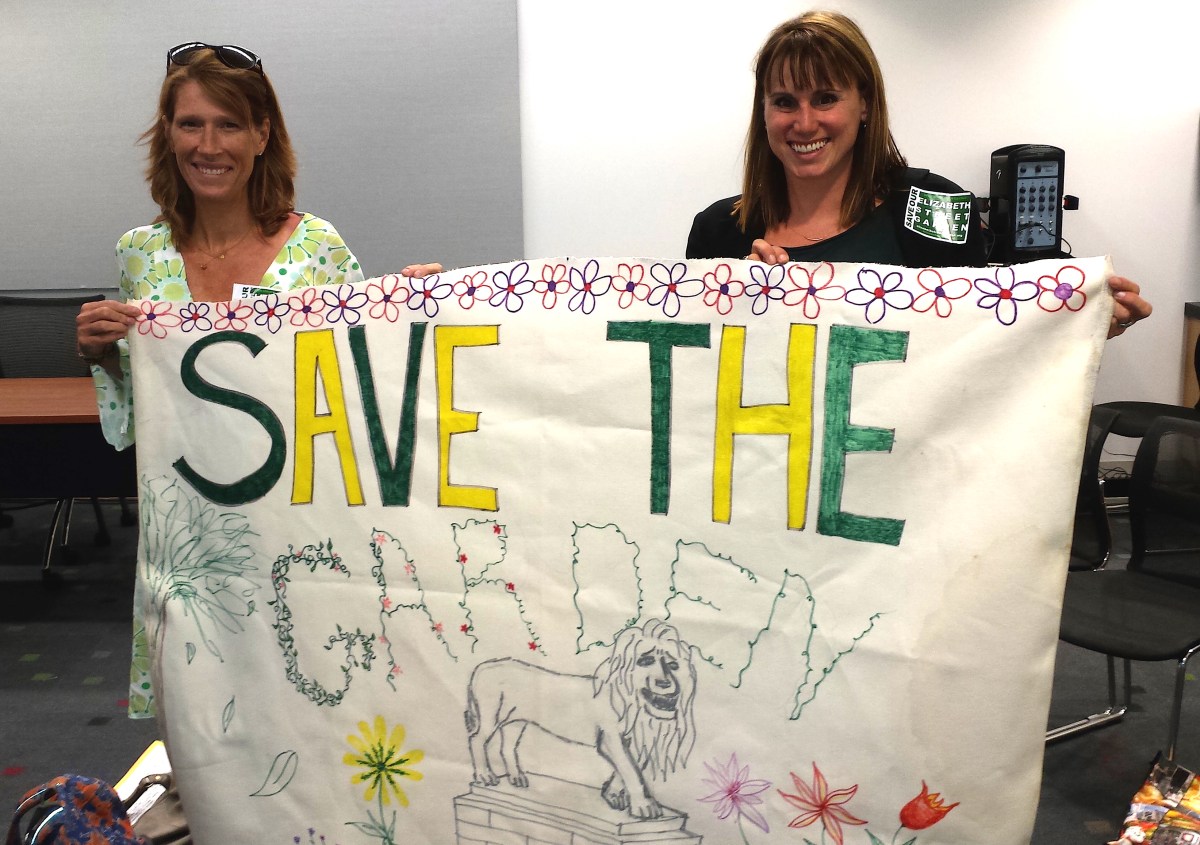
BY LINCOLN ANDERSON | About 200 supporters of the Elizabeth St. Garden packed the Lower Manhattan Development Corp. hearing last week to protest against funds being allocated to help build affordable housing on the Little Italy site. Notably joining them was Assemblymember Deborah Glick.
Far fewer, about 50 people — many of them seniors from Chinatown — came to advocate for the housing. City Councilmember Margaret Chin, the project’s main sponsor, spoke in favor of the project, and then sat up in the front of the main hearing room for the entire hearing.
The pro-garden group was so large that the crowd filled two overflow rooms, plus a balcony outside the 13th-floor hearing room at the Borough of Manhattan Community College’s Fiterman Hall.
There were many applications for money, but only the contentious garden issue saw anyone actually testify in opposition — and that organized opposition was tremendous.
Indeed, it’s rare for anyone to testify against an L.M.D.C. funding application, much less in such a massive and impassioned manner.
The L.M.D.C.’s funding pot is $50 million. The city is requesting $6 million of this for the project at 21 Spring St., the garden’s address. The agency is expected to make public its decision on the garden’s fate as soon as next month, according to Chin’s office.
Eric Wilson, associate commissioner of planning and development at the city’s Department of Housing Preservation and Development, briefly presented the housing plan.
“New York City is in the middle of a housing crisis,” he said, adding that Mayor de Blasio’s plan calls for 200,000 affordable units to be created over the next 10 years, with 40 percent of them newly constructed units.
The 21 Spring St. development would include 60 to 100 apartments in a seven-story building, with a price tag of $20 million to $24 million, he said. The $6 million L.M.D.C. grant, Wilson explained, would help H.P.D. to “target deeper affordability,” in terms of who could live there.
He said H.P.D., within the first three months of next year, would release a competitive request for proposals, or R.F.P., for developers to build the housing.
“It’s very early in the process,” he said.
Chin spoke of growing up just five blocks from the future garden when the neighborhood was known only as Little Italy — long before the trendy acronym Nolita was coined by real estate types. The garden was just a vacant site back then.
“I grew up in Little Italy, on Mott St. near Hester St., with many Italians,” she said. “For many years, I heard form neighbors about this site, that they wanted to have housing there.”
Chin noted that the city designated 21 Spring St. as a site for affordable housing back in 2012. This was done because 100 percent affordable housing — which most would say was never an obtainable goal — could not be achieved in the Seward Park Urban Renewal Area development project, which is actually in Community Board 3. The garden, however, is in C.B. 2.
“The city surveyed all of the city-owned sites in the district and found this was the best space for affordable housing,” Chin said.
Yet, C.B. 2 was never notified of this decision by the city until after the fact, and Glick said this may make it ineligible for L.M.D.C. funds.
Chin said she likes parks and gardens, but explained, “As a councilmember, you have to make tough choices and take the long view. Seniors right now are struggling to climb stairs in four-story walk-ups.”
The new building would have elevators.
“Fourteen years after 9/11, there’s a new housing boom in Lower Manhattan,” the councilmember said, adding, “The vast majority of this new construction is luxury housing.”
She added that while affordable housing is achievable at 21 Spring St., H.P.D. needs the L.M.D.C. grant to ensure that the project would be for seniors.
Meanwhile, Assemblymember Glick, in her testimony, urged L.M.D.C. to deny the application — at least until the community has been included in the process and discussion, which affects the district’s open space.
“I am gravely concerned about the location of this project,” she said. “While there is no denying that we need more affordable housing, there is also no denying that this community has the second-least amount of open space in the city and this project would eliminate a well-used and public community garden.”
Glick added that C.B. 2 has identified an alternative city-owned site that is larger and could hold even more units of affordable housing — at Hudson and Clarkson Sts. — “and equally important, it would would do so without the destruction of existing community open space.”
As she spoke, Councilmember Chin stared blankly in her direction without making eye contact. Chin folded her arms in apparent displeasure as Glick continued.
Also speaking for the garden were Tobi Bergman and Terri Cude, C.B. 2 chairperson and first vice chairperson, respectively.
Echoing Glick, Bergman said, the housing project “was sited in our board, but Community Board 2 was not notified until after the fact.”
He further told the L.M.D.C. panel, “You may hear today that this affordable housing project will happen anyway and that this is just about whether it will be senior affordable housing — that’s not true.”
Bergman urged that the housing could instead be built at the alternative Hudson Square site where “generous height and zoning allowances could allow it to be five times bigger — more units,” he said.
Councilmember Corey Johnson, who did not appear, also supports developing affordable housing at the West Side site, which is in his district.
Cude said, “Seniors, adults and children love this space and participate in its dozens of free programs each week.”
Jeannine Kiely, president of the Friends of Elizabeth St. Garden, and others noted that the Soho / Little Italy area has just a paltry .07 acres of open space per 1,000 residents.
Speaker after speaker told of how the garden has brought a magical change. One was an 84-year-old woman who said she bought an apartment nearby it as a retirement home.
“I had chosen Little Italy because it felt like a neighborhood,” she said. “Now — because of the garden — it’s become a community.”
A group of young activists began to protest, “This is not right! This totally not fair!” saying their side wasn’t getting equal time at the microphone.
Before the L.M.D.C. officials cut off the pro-garden testifiers for a while, Wenjii Zhou took the mic, then spun around to face the crowd instead of the panel. Speaking in English and then translating into Chinese, while gesturing expressively with her hands, she addressed the Asian seniors. She said that while she understood the need for housing, the neighborhood also had a great need for the open space and community feeling provided by the garden.
West Village activist Jim Fouratt said, “I’m 74 years old and I live in a sixth-floor walk-up. There is no senior housing.”
He said he was part of the creative class of people who were once drawn to Greenwich Village.
“We do not make a lot of money,” he said. “We have no place to go. There is no housing for senior creative people. This is a critical situation for us.”
K Webster is co-chairperson of the M’finda Kalunga Garden, at Rivington St. in Sara D. Roosevelt Park, but spoke against preserving the Elizabeth St. Garden. The alternative site in C.B. 2 is not suitable for senior housing, she argued.
“It’s in a high-traffic, high-density area with no grocery stores nearby — not even expensive ones,” she said.
Meanwhile, she derided the garden as “a showcase for pricey artifacts.”
Housing advocates argue that there are other parks nearby, including Sara D. Roosevelt Park and DeSalvio Playground.
However, Adam Woodward said, “All the other parks they mentioned are concrete, paved…basketball courts.”
Soho’s Lora Tenenbaum, her voice trembling with emotion, said the garden is irreplaceable for the open-space-starved area. “I am a senior and I need this garden, on 9/11 my home was filled with dust. I wore a mask inside. I need fresh air, I need green space — and that is something that seniors like me need.”
After the hearing, C.B. 2 Chairperson Bergman said that the opinion of people who actually live near the garden should take precedence.
“Everyone has a right to speak,” Bergman said, “but it’s always better when people know something about what they are speaking of. People who live a mile away in another community are unlikely to understand the community value of the garden.”
Bergman said neither the housing advocacy organizations or H.P.D. had reached out to C.B. 2 to “exchange ideas about how to get the most possible affordable housing built in our district.”
With reporting by Josh Rogers


















